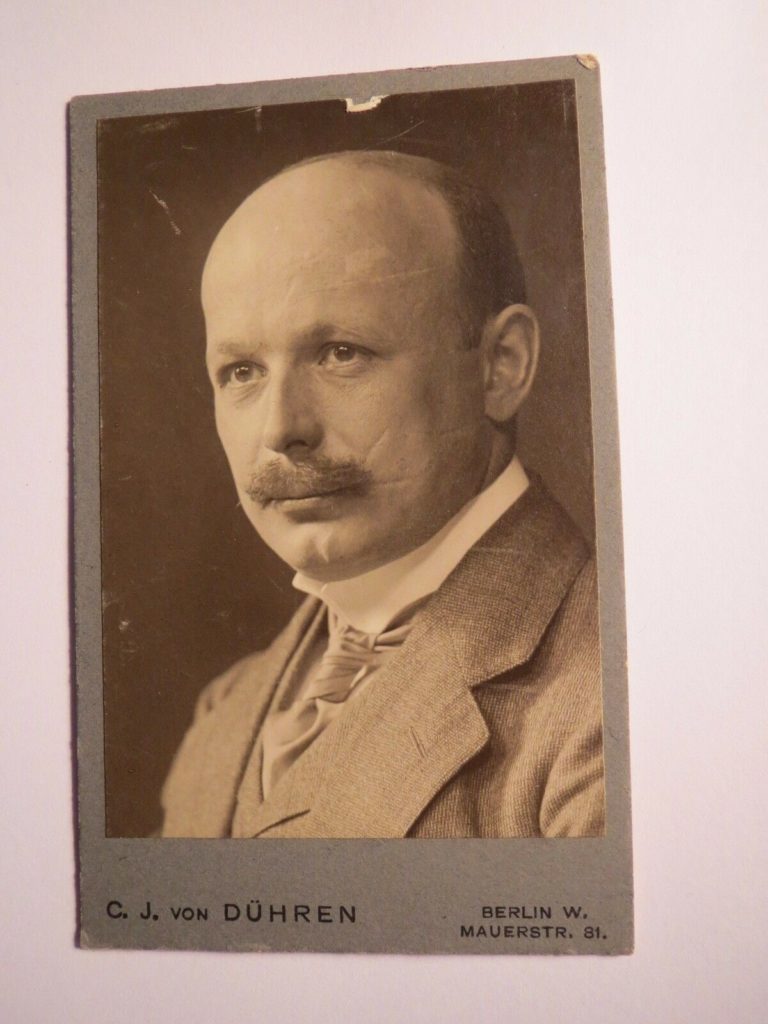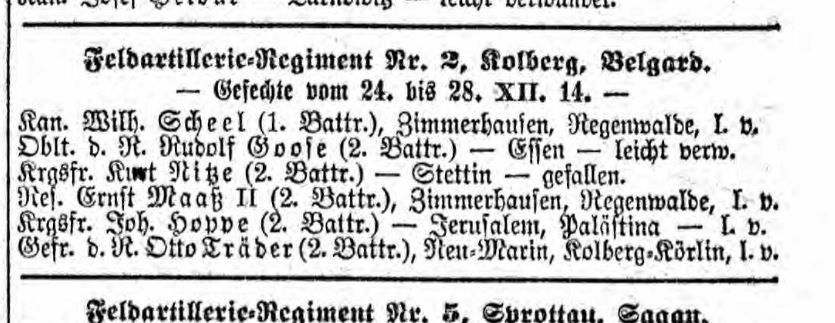Kurt Karl Goose (a.k.a. double agent GOOSE/GANDER) landed in England in October 1940 but was captured quickly thanks to an observant farmer. While MI5 tried to use him as a double agent, his wireless set could only transmit messages, not receive them, so his usefulness was limited. After a few months, Goose was sent to MI5’s long-term detention facility and languished there for the remainder of the war.
I’ve written about Goose in several other blog posts, as his case is a fascinating one. He was apparently a member of the German military, and even wore his military uniform beneath his parachute suit when he landed, just in case he was captured. Goose was quite fluent in English, thanks to his studies at the University of California (Berkeley) as a geology student, but that fluency was not enough to save him from discovery. On top of that, while incarcerated at MI5’s secret interrogation centre, Camp 020, Goose apparently tried to bribe a guard to deliver a letter to the German embassy. Such treachery was often punished quite harshly by MI5, and they even drew up a plan to prosecute him under the Treachery Act. After much discussion, MI5 backed off of that, admitting that once they had used an agent or given him a promise, they couldn’t renege on that. Goose escaped death by the narrowest of margins.
There have always been unanswered questions about Goose, even down to his real name. In some sources he was called Kurt Karl Gross and his code name was GOOSE. In others, he was referred to as Kurt Karl Goose and his code name was GANDER. On top of that, his Security Service file has never been released to the National Archives. It’s possible that it was weeded out in the 1960s and 1970s, or it may still reside within the MI5 archives.
For those interested, here are links to my three previous blogs about Goose:
- The Mystery Spy – Double Agent GOOSE/GANDER (2015) – outlines his capture and interrogation, what we know of it
- Follow-up to Double Agent GOOSE/GANDER (2016) – some extra bits of information related to his capture and the village of Bozeat
- Mystery Spy GOOSE/GANDER – Kurt Karl Goose (2019) – tracked down genealogical records which confirm his real name
Ancestry Tree
On a regular basis, I scan through the genealogical records, trying to close loops on various open cases. A few months ago, I noticed that Ancestry had expanded its range of death registrations for Berlin, from the 1930s until the mid 1950s. In the hopes of tracking down a death for Kurt Karl Goose, a native of Berlin, I searched through the records and hit a jackpot!
Someone had posted a family tree for Kurt Karl Goose! While there were dates and locations for births, marriages and deaths, there was not, however, any supporting documentation. I reached out to the individual who posted the tree, but have yet to hear back.
Still, the tree provided me with enough information to begin a not so wild goose chase, mining the genealogical database yet again, and discovering some more information about Goose.
Parents
Kurt Karl Sophus Goose was born 12 June 1911 in Berlin, which jives with what we know from other sources. His parents were Peter Rudolf Karl Goose and Rosa (Rosl) Elise Edeltraud Stepp. This makes sense as well, since the Berlin address books led me to suspect that his mother was Rose/Rosa Goose.
Kurt’s father, Rudolf, was born 30 September 1874 in Altstadt (Essen) to Karl Friedrich Sophus Goose, a lawyer (“Doktor juris”) and Berta Henriette Marie Goldschmidt. Kurt’s grandfather, Karl, had been born in Zetel, Friesland, Lower Saxony but Berta was born in Berlin and the couple had married in Berlin in 1869. At some point in the early 1870s, they had moved to Essen where Kurt’s father, Rudolf, was born.
Kurt’s moth er, Rosa, had been born 9 June 1885 in the Bavarian city of Nürnberg. Her parents are, however, unknown. Some of dates are from the Family History Library (FHL) indices which do not include images. I did have a look at FamilySearch.org (the FHL site) and it linked to the Nürnberg archives for Rosa and Peter’s marriage but the link only took me to the archives main page. I have yet to figure out how to navigate the archives to find their marriage registration. According to the FamilySearch index, the couple was married on 23 July 1910 in Nürnberg.
Life in Berlin
From there… given that Kurt Karl Goose was born a year later in Berlin, we know that the family had settled in Berlin by then. The following year, on 29 December 1912, the couple had a second child, Ingeborg Elsbeth Anna Maria Goose. Both of the children’s birth certificates are not available on Ancestry since there is a black out on births after 1908. But Rudolf and Rosa had at least one more child, a stillborn girl born in 1914. Her death was registered on 9 September 1914 and has a a few small bits of information on the couple. Rudolf was apparently a Magistratsrat and the family was living at Keithstrasse 22, just southeast of the Berlin Zoo. With that address, and Rudolf’s occupation, I was able to trace Rudolf Goose through the Berlin address directories:
- 1914 – Magistr. Rat, W62, Keithstr. 22 III.
- 1916 – Magistr. Rat. W62, Keithstr. 22 III.
- 1918 – Magistratsrat, Stellvertr. Direktor d. New Yorker Germania, Lebens Vers. Ges. Berlin, W62, Keithstr. 22.
- 1920 – Magistratsrat a.d., Gen.-Dir. d. New Yorker Germania, Leb.-Vers. Ges., Europ. Abt., Berlin, W62, Keithstr. 22.
- 1924 – Magistratsrat a.D., Generaldirektor, Neue Königstr. 57a.
- 1926 – Magistratsrat a.D., Generaldirektor, Potsdam, Neue Königstr. 57a.
- 1928 – Magistratsrat a.D., Generaldirektor, Potsdam, Neue Königstr. 57a.
- 1931 – Mag.-Rat a.D., Gen.-Dir., Potsdam, Neue Königstr. 57a.
At first, I thought Magistrat/Magistratsrat might have something to do with the legal profession since “magistrate” in English generally refers to a judge, but it would appear not. Magistratsrat seems to be equivalent to a city or town councillor. It would also appear that Rudolf was involved with the New Yorker Germania Lebens Versicherungs Gesellschaft (New Yorker Germania Life Insurance Company), first as a Stellvertreter Direktor (Deputy Director) and then as General Director. According to one archival site, the New Yorker Germania company later became known as The Guardian Life Insurance Company of America. The company is still in existence today although their official history made me wonder if they were the same company. Some more digging has revealed that yes, it is the same company but it went through some restructuring during the 1920s, particularly after the hyperinflationary period that crippled Germany in the early to mid-1920s.

Offices at 12 Leipziger Platz in Berlin.
While searching for “Rudolf Goose” and “Berlin”, I came across an archival page from the Zentral and Landesbibliothek Berlin which refers to our friend Rudolf.
J. -Nr. 1219 St. V. 1/12.
1112. Vorlage (J.-Nr 594 0. B. 3/12) — zur Beschlußfassung —,
betreffend die Anstellung eines Magistratsrats.
Der Magistratsassessor Rudolf Goose, geboren am 30. September 1874 und hier Keithstraße 22 wohnhaft, ist am 1. Dezember 1905 in den hiesigen städtischen Dienst als juristischer Hilfsarbeiter eingetreten und vom 1. Dezember 1906 ab nach den Bestimmungen der Ortsstatute vom 10./15. März 1892 und 28. April/3. Mai 1902 als Magistratsassessor auf sechs Jahre angestellt worden. Dieser Zeitraum läuft am 30. November d. Js ab. Herr Goose war zuerst in der Armendirektion tätig und ist jetzt in der Schuldeputation, in der Deputation für Statistik und als ständiger Vertreter des Oberbürgermeisters bei Ausübung der Schul polizei beschäftigt, auch ist er Leiter des Nachrichtenamts. Er ist ein befähigter, fleißiger und kenntnisreicher Verwaltungsbeamter und besitzt große Geschästsgewandtheit. Wir halten daher sein dauerndes Ver bleiben im städtischen Dienst für die Stadtgemeinde für vorteilhaft wollen ihn vom 1. Dezember 1912 ab als Magistratsrat auf Lebens zeit anstellen.
Die Stadtverordnetenversammlung ersuchen wir um Aeußerung über die beabsichtigte Anstellung gemäß § 56 Nr. 6 der Städteordnung.
Berlin, den 4. Oktober 1912.
Magistrat hiesiger Königl. Haupt- und Residenzstadt.
Dr. Reicke
And… with a bit of help from Deepl traslator… we have…
J. No. 1219 St. V. 1/12.
1112th Submission (J.-Nr 594 0. B. 3/12) – for resolution -, concerning the appointment of a magistrate.
The Magistrate’s Assessor Rudolf Goose, born on 30 September 1874 and residing here at Keithstrasse 22, entered the municipal service here as a legal assistant on 1 December 1905 and was employed as Magistrate’s Assessor for six years from 1 December 1906 in accordance with the provisions of the local statutes of 10/15 March 1892 and 28 April/3 May 1902. This period expires on 30 November this year [1912]. Mr Goose was first employed in the Directorate for the Poor and is now employed in the School Deputation, in the Deputation for Statistics and as permanent representative of the Lord Mayor in the exercise of the School Police, he is also head of the News Office. He is a capable, hard-working and knowledgeable administrative official and possesses great great business acumen. We therefore consider his continued employment in the municipal service to be advantageous for the municipality. We want to employ him from 1 December 1912 as a magistrate for life.
We request the City Council to make a statement on the intended appointment in accordance with § 56 No. 6 of the City Code.
Berlin, 4 October 1912.
Magistrate of the Royal Capital and Residence City of Berlin.
Dr. Reicke
Well, that sheds some light on Rudolf’s career. It would appear that he was already in Berlin in 1905, employed as a legal assistant for the municipality of Berlin. Seven years later, in 1912, when this submission for lifetime magistrate was made, he had already served in several departments in the municipal government of Berlin. Clearly, according to the Berlin address books, he continued in the role of Magistratsrat for several more decades.
“Smacks in the Face by Mensur”
We now come back to the Ancestry tree which has a death date for Rudolf – 23 March 1931, in Berlin. I have hunted high and low through the Ancestry death records of Berlin but could find no death registration for Rudolf. He may be indexed incorrectly and it is a bit like looking for a needle in a haystack when that occurs.
I did, however, find a fascinating photograph posted for sale on eBay. The description simply notes: “Berlin – Rudolf Goose – gestorben 1931 – Schmisse im Gesicht von Mensur / CDV”. The first part of the description translates as: Berlin – Rudolf Goose – died 1931. I admit to being initially baffled by the second part of the description which, when run through Google Translate and Deepl yielded this impenetrable phrase: “Smacks in the Face by Mensur / CDV”. Rather perplexing.
Looking at the photograph, I wondered if the marks to the right of Goose’s mouth could be scars. And while “Mensur” did not translate from German to English, that was because it was a Latin word, specifically a fencing term. Mystery solved! The marks on his face are fencing scars. Apparently, back in the day (and apprently even today), certain student groups practised Mensur, “a traditional, strictly regulated épée/rapier fight between two male members of different fraternities with sharp weapons”. The resulting scar from a hit was called a “smite” (Schmiss) and was seen as a badge of honour. I’ve seen some photographs online of fencers after their Mensur fight. Rather gory!

Rudolf’s War Service
I tracked down one last bit of information on Rudolf Goose, a mention in the German war casualty lists published on 18 January 1915:

The casualty list is for the Field Artillery Regiment Nr. 2 , Kolberg, Belgard. with casualties from 24-28, December 1914. These included several soldiers from the 2nd. Battery along with Oblt. d. R. (First Lieutenant of the Reserve) Rudolf Goose (2. Battr.) – born in Essen – who was lightly wounded. One could wonder if this is our guy except that he was born in Essen. Born in 1874, Rudolf likely served two years of compulsory military service in his late teens/early 20s (early to mid 1890s). After his service, he would likely have been placed on the Reserve list, ready to be called up in the event of war. Given that our Rudolf was 39 at the outbreak of the war, it is, of course, always possible that this is a completely different Rudolf Goose.
Rosa Goose
All of the bits and pieces about Rudolf jive with what I had discovered in earlier blog posts. Rosa Goose was the widow of a General Director and living on her own in Berlin during the mid 1930s. We know that by 1934, she had moved closer to the centre of Berlin, to Hohenzollerndamm 91. In the 1934 directory, she isn’t even listed under her Christian name, simply: Goose, Gen. Dir. Wwe (i.e. widow of a General Director).
As for what became of Rosa after the war, all we know from the Ancestry tree is that she passed away 14 October 1972 in Heidelberg, Baden-Württemberg. A bit of digging revealed a Heidelberg phone directory from 1959/1960 which listed a Rosa Goose, widow, living at Bergstrasse 107. How she came to move there is a mystery. Perhaps one of her children moved to the area after the war?
The Sister of Kurt Karl Goose
One thing leads to another and here we are digging into the life of the formidably named Ingeborg Elsbeth Anna Maria Goose. Born in 1912, she lived to the ripe old age of 92, passing away in Mannheim on 3 September 2005, according to the Ancestry tree. Beyond that, all we know about her is that she married a gentleman named Hubert Tellenbach (born 1914 in Düren – a town between Aachen and Köln) who had passed away on 4 September 1994 in München. But… this is just enough information to make the connection! In the 1959/1960 Heidelberg directory, guess who was also living at Bergstrasse 107? Yup… Hubert Tellenbach, Dr. Prof. Psychiater (psychaitrist). Too much of a coincidence I think. So it would appear that Rosa moved in with her daughter and son-in-law at some point after the war.
A bit more digging on Dr. Hubert Tellelbach revealed that we was actually a fairly well-known psychiatrist, who even has his own Wikipedia article, portions of which are roughly translated below:
Tellenbach studied medicine and philosophy in parallel in Freiburg im Breisgau, Königsberg, Kiel and Munich from 1933 to 1938 and earned a doctorate in both subjects. His encounter with Martin Heidegger in Freiburg was formative. During the Second World War, he was deployed as a troop doctor and was taken prisoner. He then worked as a neurologist in Munich, where he habilitated [N.B. 2021 08 30 – It is an educational term related to achievements in research/teaching prior to holding a full professorship. ] in 1952. In 1956 he moved to Heidelberg and held an associate professorship there from 1958. During the years of student unrest, he headed a specialist group on psychiatry/psychosomatics. From 1971 until his retirement from the clinic in 1979, he was Medical Director of the Department of Clinical Psychopathology created for him. Tellenbach is the father of the German prehistoric archaeologist Michael Tellenbach.
While it appears that Hubert has a photograph on Google, a white-haired gentleman with a bony face, that photograph actually appears to belong to Roland Kuhn. I did eventually find an image of Hubert on the cover of one of his books from 1981.

I was a bit disappointed to find no mention of Hubert’s wife in the Wikipedia article but… after some more searching, came across information on the My Heritage site. Apparently Ingeborg was a medical doctor, a “Dr. Med.”. According to My Heritage, she and Hubert had three children. Alas, I have run out of email addresses with which to sign up for a free trial on MyHeritage! On the other hand, I did find a Dr. Med. Ingeborg Tellenbach living in München at Nußbaumstrasse 14 in 1943 so she was clearly married by that point and well on her own career path. A bit more digging revealed that in 1940, Ingeborg was a “med. prakt.” (medical practitioner) residing at Nußbaumstrasse 14 in München. At first, I thought that perhaps she and Hubert and married between 1940 and 1943, but that is not the case. A biography of Hubert Tellenbach on the Deutsche Biographie site notes that the couple married in 1939. It is likely that Ingeborg was simply still listed under her maiden name in the 1940 directory. The Deutsche Biographie site also notes that Hubert had been in military service since 1939, was severely wounded in 1942 but deployed again on the Western Front in July 1944. In 1945 he was captured by the Allies and held for a short time before being released at the end of hostilities.
Well, this wild goose chase has taken us down quite the rabbit hole. Let’s see if we can return to the original quarry of this blog post.
The Fate of Kurt Karl Goose
What actually became of our former double agent, Kurt Karl Goose? According to the Ancestry tree, Kurt passed away on 23 March 1973 in Bottrop, a suburb just north of Essen. He appears to have come full circle, returning to the site of his own father’s birth. It strikes me as being a bit odd that both father and son died on the same day (23 March). Hopefully I hear back from the Ancestry member who posted the tree.
N.B. 2021 08 30 – Thanks to Traugott Vitz for sending me the Wikipedia link on habilitation!
